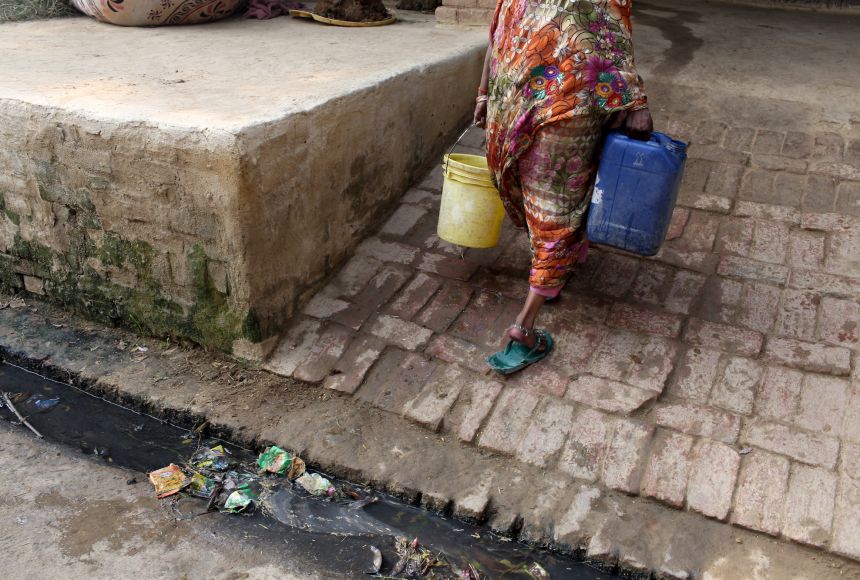More than 70 percent of Earth’s surface is covered in water, yet lack of access to clean water is one of the most pressing challenges of our time. As of 2015, 29 percent of people globally suffer from lack of access to safely managed drinking water. More than double that number are at risk for water contamination from improper wastewater management. Poor water quality affects various aspects of society, from the spread of disease to crop growth to infant mortality. In some regions of the world, lack of sanitation infrastructure, water treatment facilities, or sanitary latrines lead to dire clean water crises.
In several countries around the world, a major contributor to water contamination is open defecation—the practice of using fields, forests, lakes, rivers, or other natural, open areas to deposit feces. Almost one billion people worldwide still practice open defecation rather than using a toilet. It is particularly common in South Asian countries like India and Nepal, where it is practiced by about 32 percent of people in the region. A landlocked country in the Himalayas, Nepal has access to clean water from mountain rivers, but over 20 percent of the population lives below the poverty line. In a disturbing study, 75 percent of drinking water samples from schools in Nepal were contaminated with fecal bacteria. While open defecation is most common in rural communities, it still occurs in areas with sanitation access, indicating a need for awareness campaigns to teach the dangers of the practice. Moreover, pollution from open defecation is further complicated by contamination from natural disasters such as recurring floods.
In sub-Saharan Africa, the proportion of the population practicing open defecation is slightly smaller—around 23 percent—but 40 percent of the population lacks safe drinking water. Moreover, the gender inequality in this region is more prominent than in South Asia. In sub-Saharan Africa, more than 25 percent of the population must walk 30 minutes or more to collect water, a burden that falls on women and girls the vast majority of the time. This trend of women tasked with the responsibility of water collection spans many developing nations and takes critical quality time away from income generation, child care, and household chores. Moreover, Africa has a high risk for desertification, which will reduce the availability of fresh water even further, and increase the threat of water inequality in the future.
While South Asia and sub-Saharan Africa represent the largest percentage of people that lack access to safe drinking water, the water crisis is not limited to these areas, nor is it limited to developing countries. For example, the Arctic nations are deemed developed, but several suffer from water and sanitation challenges. Alaska in the United States, Russia, and Greenland all contain rural areas that lack safe in-house water and sanitation facilities. Some people living in these areas must not only carry their own water into their homes, they must also remove human waste themselves, collecting it and hauling it out of the home. The process is time consuming and risks contamination of household surfaces and drinking water. Furthermore, hauling water into homes is physically demanding, and storage capacity is limited, so households often function on inadequate water supplies. Several studies have connected these water-quality constraints with high disease rates in Arctic communities.
Even in the United States and many nations in Europe, where advanced wastewater treatment facilities and expansive pipelines supply quality water to both cities and rural areas, poor system maintenance, infrastructure failures, and natural disasters reveal the very serious effects of poor water quality (even short-term) on developed nations. In a recent example, drinking water in Flint, Michigan, was inadequately treated beginning in 2014, and residents bathed in, cooked with, and drank water with toxic lead levels. Additionally, some communities in the contiguous United States chronically lack clean water and sanitation. According to the U.S. Environmental Protection Agency (EPA), in the Navajo Nation, the largest Native American reservation in the United States, almost 8,000 homes lack access to safe drinking water, and 7,500 have insufficient sewer facilities.
Luckily, global organizations are committed to addressing the water-quality crisis. The 2030 Agenda for Sustainable Development from the United Nations tackles water inequality within one of its seventeen priority goals, to “ensure availability and sustainable management of water and sanitation for all.” This initiative is a continuation of the United Nations’ Millennium Development Goals from the 2000s, which also included goals to reduce the portion of the population that lacked access to infrastructure for quality water and sanitation. These goals have resulted in access to improved sources of drinking water for more than 90 percent of the world—and the 2030 Agenda seeks to continue to improve these numbers alongside greater strides in the area of sanitation.
National Geographic Explorers are also committed to global water equality and are combatting these issues with diverse methods. Explorer Sasha Kramer is helping to implement sustainable sanitation practices in Haiti by recycling human waste into soil. Explorer Ashley Murray develops economically advantageous approaches to improving water quality in Ghana, exploring next-generation technologies and new business models to make waste management profitable. Explorer Alexandra Cousteau, granddaughter of the late and legendary Jacques Cousteau, uses storytelling and digital assets to educate people around the globe about the importance of water quality. Moreover, complementing these examples and the many other Explorer-driven efforts dedicated to improving water quality, Explorer Feliciano dos Santos uses music to educate remote villages in Mozambique about the importance of sanitation and hygiene.
